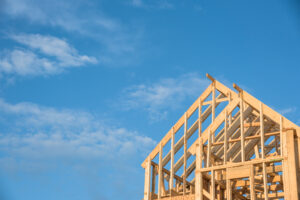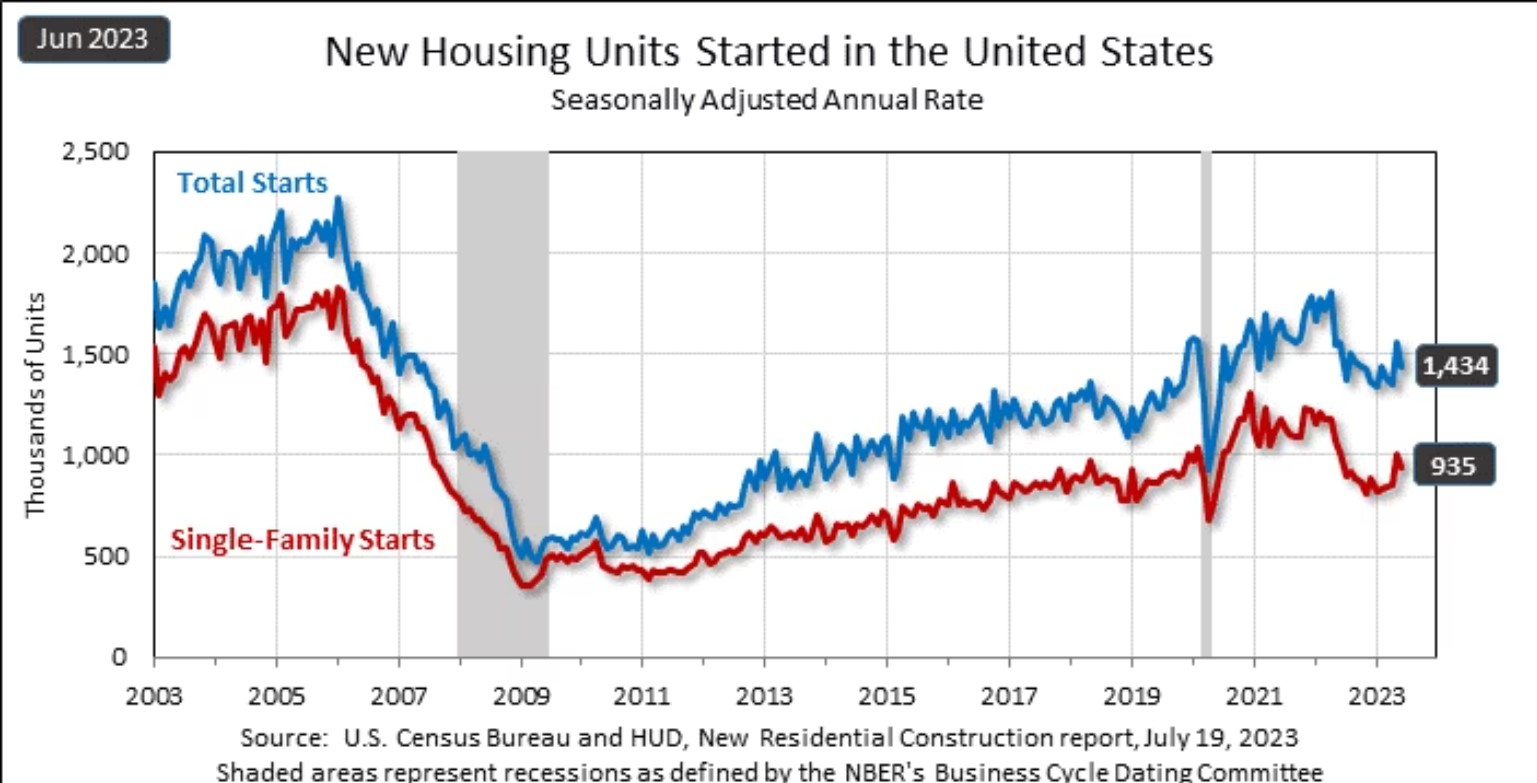 The U.S. Census Bureau has released its latest batch of data covering building permits, housing starts, and housing completions that took place in June.
The U.S. Census Bureau has released its latest batch of data covering building permits, housing starts, and housing completions that took place in June.
Building Permits:
Privately-owned housing units as counted by issued building permits came in at a seasonally adjusted annual rate of 1,440,000 units. This number is 3.7% below the recorded rate in May, which was 1,496,000 and 15.3% below numbers in June 2022 when that rate came in at 922,000. Authorizations of multi-family units with five or more units were at a rate of 467,000 in June.

Housing Starts:
Privately-owned housing starts in June were at a seasonally adjusted annual rate of 1,434,000. This is 8% below the revised may estimate of 1,559,000 and 8.1% below the revised rate year-over-year which predicted a rate of 1,561,000. Single‐family housing starts in June were at a rate of 935,000; this is 7.0 percent below the revised May figure of 1,005,000. The June rate for units in buildings with five units or more was 482,000
Mark Palim, Deputy Chief Economist for Fannie Mae commented on the report:
“Today’s new residential construction report from the Census Bureau showed that single-family starts declined 7.0% to a seasonally adjusted annualized rate (SAAR) of 935,000 in June, largely in line with our expectations following the unusually large 18.7% jump in starts the month prior. Still, the level of single-family starts remains robust, and we believe ongoing near-term strength is likely given the continued upward trend in permits, which rose 2.2% to a SAAR of 922,000."
“Signs continue to point to a clearing of previous backlogs caused by material and labor shortages, as the number of single-family units under construction has fallen 17.0% over the past year. Additionally, the rate of permits and starts are continuing to converge with completions, which have hovered around an annualized pace of 1 million over the same period. We estimate this completions pace to be approximately the potential starts capacity of the single-family home construction industry, once all backlogs are fully returned to normal. While we continue to expect some pullback in starts by the end of the year, this is contingent on broader economic conditions weakening. If the economy continues to expand in the coming quarters, we think starts are capable of moving toward an annualized pace of 1 million units as demand remains sufficient given the ongoing lack of existing homes available for sale.
“Multifamily starts declined 9.9% to a SAAR of 499,000, also largely in line with our expectations. While multifamily starts have hovered around the same level since the end of 2021, the typically more-indicative permits series dropped 12.8% to a SAAR of 518,000 and has generally been in decline for a year. We continue to expect the rate of multifamily starts to slow as national rent growth is sluggish and tighter bank lending conditions likely weigh on future projects.”
Housing Completions:
Privately-owned housing completions in June stood at a seasonally adjusted annual rate of 1,468,000. This number is 3.3% below the revised May estimate of 1,518,000 but is also above the June 2022 rate of 1,392,000. Single-family housing completions in June were at a rate of 986,000, this is 2.8% of the revised below the revised May rate 1,014,000. The June rate for multi-family units with five or more units was 476,000.
According to First American Deputy Chief Economist Odeta Kushi, June housing starts have started to step away from May, but remain elevated as builders continue to benefit from the lack of existing-home inventory.
Kushi continued by saying:
“U.S. housing starts in June came in below expectations at a seasonally adjusted annual rate of 1.434 million, which is 8.0% below the downward revised May estimate of 1.559 million and 8.1% below the June 2022 rate of 1.561 million.”
“While permits, a leading indicator of future starts, ticked up 2.2% month over month, the pace of construction slowed as single-family housing starts were down 7.0% month over month, meaning less groundbreaking on new homes, and single-family completions were down 2.8% month over month, meaning less supply was added to the housing stock.”
“Builder sentiment inched higher in July to the highest level since June 2022. Yet the rise was slower than in months prior, a sign of moderating and cautious optimism. Of the index’s three components, current sales conditions and buyer traffic increased, while sales expectations fell.”
“There remains pent-up demand in the housing market, but higher mortgage rates put a strain on affordability. Mortgage rates were 6.67% in the week ending June 22nd. By July 13th, mortgage rates had drifted to approximately 7%. Holding household income constant, the increase in mortgage rates reduced house-buying power by approximately $10,000.”
“Builders are benefitting from the lack of resale inventory, but higher mortgage rates pose a threat. Reduced affordability alongside ongoing supply-side challenges and tighter lending standards for acquisition, development and construction (AD&C) loans could throttle builder momentum.”
“While down from the peak reached in the spring of last year, there remains an elevated number of single-family homes under construction. A record number of multifamily units are under construction. When these units are completed, it should put some downward pressure on prices.”
“Note the steady increase in single-family housing permits, a leading indicator of future housing starts. There is a significant shortage in the U.S. housing market, and existing-home supply is insufficient to meet the demand. As a result, builders are stepping up.”

 DSNews The homepage of the servicing industry
DSNews The homepage of the servicing industry









